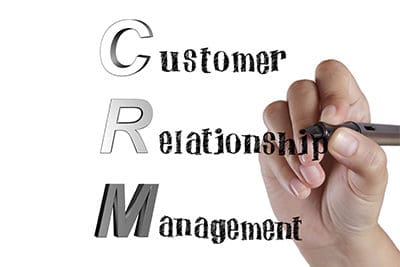What is Custom Management or Custom Relationship Management (CRM)? Do I need a CRM to make the best of my customer service team, and improving my client service?
On the one hand and according to TechTarget, Customer Management or CRM (Customer Relationship Management):
Customer relationship management (CRM) is a term that refers to practices, strategies and technologies that companies use to manage and analyze customer interactions and data throughout the customer lifecycle, with the goal of improving business relationships with customers, assisting in customer retention and driving sales growth.
According to Joe Galvin for The Sales Force, we find the definition of Customer Management in more technical and precise terms:
The essential elements of a customer management strategy are:
1. Managing Relationships. For every sales professional, the sales culture in which they work shapes their understanding of what it means to manage customer and prospect relationships. Sales leadership provides a framework that accounts for cost of sales, market position, complexity of the product or solution and other factors.
2. Creating Opportunities. Prospecting is hard and lonely work, and often it isn’t even time well spent. Marketing needs to get the right messages out—via the right channels—to generate demand that can be converted into qualified leads so that the sales team’s prospecting efforts actually lead to meaningful new conversations. Many companies are now encouraging their salespeople to be active in social channels, but this can do more harm than good if these individual efforts are not in sync with marketing’s messages.
3. Managing Opportunities. The first step in managing opportunities is to qualify them. Beginning with a proven strategy helps salespeople use defined criteria to determine which opportunities are worth the investment of their time and resources. The second step is to learn as much as possible about the customer’s decision dynamic—buying influences, customer issues and competitive positioning. That will form the basis of the next customer interaction. From there, at each step of the way, a good customer management strategy provides the guidance and insights to allow the salesperson to confirm that the opportunity is on track.
In short, a Customer Relationship Management help us to best comprehend our clients; knowing their roots in terms of social and age groups, and what are their particular needs. Having this knowledge help us to offer them the best solution to their needs at the shortest time possible, under their own terms.
On the other hand, we find consumer profiles. Much has been said about this subject from different points of view: Habits, age groups, their distinguishing contributions to the world and, especially, their social behavior in the digital era.
 About this last point and particularly highlighting the use of the Internet, social networks and similar channels; we are experiencing a very interesting era that offers much opportunities. Unfortunately, they seem to be underutilized or misused.
About this last point and particularly highlighting the use of the Internet, social networks and similar channels; we are experiencing a very interesting era that offers much opportunities. Unfortunately, they seem to be underutilized or misused.
This is because plenty researches or studies on consumer profiles seem to focus and limit to the grounds of marketing. In other words, readings and interpretations on age groups can be addressed to best exploit Customer Management.
Let’s give a look on our customer’s social behavior in the cyberspace so we can make the best for our Customer Management.
Customer Management: Age groups and consumer behavior
Baby Boomers (1946-1964)
They are between 50 and 68 years. Their distinguishing features as consumers are:
- They were born during the post-war period (World War II), when birth rates suffered significant increment.
- Women of this generation gradually begun to incorporate to the labor market. This meant the breaking down of traditional family model with the subsequent birth control.
- They believe in fidelity: They built up long standing working relationships; they prefer to use traditional brands and direct interaction with their peers.
- A significant percentage of this generation is already widow/widower. Their interests include healthy life; sports clubs and online dating. They use social medias to keep in touch with their close friends and family.
- They like to read books and newspapers in traditional formats. However, more and more baby boomers are using digital platforms to do it; generally helped or introduced by a member of the Generation X or Millennial from their family or close friends circle.
- They follow social groups linked to their interests, and they are ready to watch tutorials to solve specific issues, and for entertaining.
How to deal with these users?
A baby boomer will always prefer to give a phone call and explain in detail his or her problem. Same, this customer will expect that the same service operator conducts him/her from end to end.
Also, a baby boomer will take longer in getting used to automated platforms. In other words, this user will require more assistance until fully understanding the correct way to process tickets and requirements.
Generation X (1965-1978)
They are currently between 36 and 49 years.
- The labor market is an option that most women take. Motherhood, while important, isn’t the only goal they desire to achieve.
- Same as the previous age group, they give importance to fidelity; show great interest in building long term relationships based on confidence; and believe in cooperative work teams. Also, they demand quality over quantity.
- They believe in job worth doing careers, and look for projections and promotions in the companies they work for.
- It was the last generation who knew life before the massification of the Internet. Therefore, this age group has best adapted to technology changes, and has enjoyed the best of both worlds.
- Same, they use Internet as primary source of practical information (tutorials), for shopping, etc.
How to deal with these users?
A Generation X member will be more autonomous and will query at the CRM only after having tried to solve his/her request by him/herself. So it’s much better to pay attention on how far he/she has got to give solution.
Same, a Generation X member will take for granted that it won’t be necessary to repeat neither his/her basic information; nor the information related to his/her ticket.
Generation Y or Millennials (1979-1996)
Currently, they are between 18 to 35 years.
- More women on this age group postpone motherhood, and even consider not to form family at all. In parallel, they aim to develop as professionals and they generally don’t give up on it.
- If decide to form family; women on this group demands full cooperation of their immediate family regarding domestic affairs. Otherwise, they will raise their children as mono-parental family.
- Likewise, women demand the same rights and equality in social, work and family issues.
- When it comes to work, they believe in cooperative rather than hierarchical systems. They are more tolerant to failure, and fresh starts represent opportunities instead of setbacks.
- Different from the previous age groups, this generation is more willing to experiment. So they aren’t so attached or interested in building long-term working relationships. In other words, they’re more entrepreneurial, independent, and give high value to cooperative decision-making.
- They keep pace with technology, and they can’t imagine life without digital devices. They are cross-platform; or multi-screen consumers.
- Among their favorite activities they count traveling and shopping. For this purpose, they usually use digital channels to book tickets, making reservations and similar. Same, they love doing digital shopping and perform virtual tracks on their purchases.
- Millennials are very visual. For this reason, they prefer social networks where they can show themselves on pictures, exposing their comments in real time, and valuing their peer’s lives; like living from and for the screen.
- They are quick-tempered, critical and demanding. A bad service experience is more than enough to dispose over a brand; and they won’t hesitate in damaging via social medias the reputation of companies that don’t meet their demands.
How to deal with these users?
Millennials will behave similarly to the last age group: They will query at the CRM only after having tried to solve his/her request by him/herself.
However, they will be more prone to intolerance and impatience. So the service operator must offset such behavior.
Finally, a millennial will also take for granted that it won’t be necessary to repeat neither his/her basic information; nor the information related to his/her ticket.
Generation Z (From 1995)
Individuals who are currently under 18.
- This group still hasn’t entered to the labor market; however, their individuals do consume technology and they are emerging as the most consumerist group to date.
- Generally speaking, they give much importance to hobbies, and they consider them as potential ideas for making business. They tend to be enterprising, selfless and highly social.
- Also, they classify telecommuting as the ideal job, with flexible schedules. They show great interest in getting involved in more than one project at a time. Same, they prefer services and innovative products over fidelity, and they aren’t loyal to particular brands. They value innovation above all.
- As they grew with technology, it’s pretty hard for them to imagine a world without multiple devices on their disposition. Additionally, they are ambivalent: On the one hand, they tend ridicule and mock about the others age groups limitations regarding to technologies; while on the other hand, they serve them as mentors.
- Same, as they are extremely creative, they tend to get easily distracted and bored. Also, they worry about people, environmental issues and the social impact of world events.
- They are practically addicted to social networks. However, to keep anonymity or simple rebellion, they prefer to use social networks where their parents or guardians do not interact very often.
- They are more cross-platform consumers than Millennials.
How to deal with these users?
As technology native users, the “Z” individuals will always be the most proactives and interactives, and will query the CRM service via social medias. They will channel and track down their tickets to qualify on spot the customer service.
Furthermore, if your CRM service counts with highly attractive interface, the Z’s will be delighted to fill out forms and surveys. You can make a profit of this disposition for marketing your brand and services.
However, we recommend to customize and restrain your interface to avoid over exposition.
Now, how to exploit these profiles for Customer Management?
After considering these age group profiles, it’s pretty clear that most consumers of technology are among the younger generations.
However, we should keep in mind that there are four generations interacting in the cyberspace and demanding your services, with their well-defined features. From the fully comprehension of their behavioral traits will come out the best strategies for your Customer Management.
We can achieve this goal by exploiting the common points in each profile. So, additionally to the specific recommendations by age group to maximize Customer Management; you should adopt a CRM that also takes into account these features:
1. Customization and new values
Customer Management software must evolve towards Social CRMs. In other words; they should study, incorporate and exploit the fingerprinting, social behavior and information shared online by their customers.
This, for gaining greater insight into each age group profile. This best practice allows better campaigns profiling, and targeting better strategies addressed to each population sector.
2. Promoting transparent, collaborative environments
Empowering your clients is a value that individuals belonging to all age group profiles. So, knowing how to engage your customers in the contribution of ideas for the creation and development of solutions and products; is a strategic advantage that will make you gaining their loyalty.
3. Align your Customer Management software to your products, solutions and profiles
There are many solutions for Customer Management. They can be classified as operational, analytical, and collaborative CRMs. The last ones are also called on demand or SaaS (Software as Service) software. Among them, highlight the mobile-first and open source software models.
However, each one of these models provide unique features that you must check carefully before committing to one in particular.
4. Keep in mind the members of your work teams
By age, your employees also belong to an age group profile that you can perfectly exploit on behalf of your customers; and therefore, on your company’s behalf. Logically, people understand the better among their peers, sharing the same codes, understanding their concerns and needs.
However, rather than constrain them to give attention to a single profile determined by age range, you better mix up things. This strategy takes out the best for service management.
Making collaborative work enhances the quality of information shared between employees, promotes streamlining processes; and promotes the formation of customer relationships. All this points to provide the best level of service.
Customer Management is a process that involves social interactions. These can be enhanced with automated tools or solutions. For best results in financial terms, Customer Management requires the support of automated and comprehensive CRMs to look after the needs of customers.
We offer the best solutions to make easier your Customer Management processes, and make the best of their social behavior in the cyberspace while encouraging your relationship with your customers.
Solutions in Customer Relationship Management CRM





